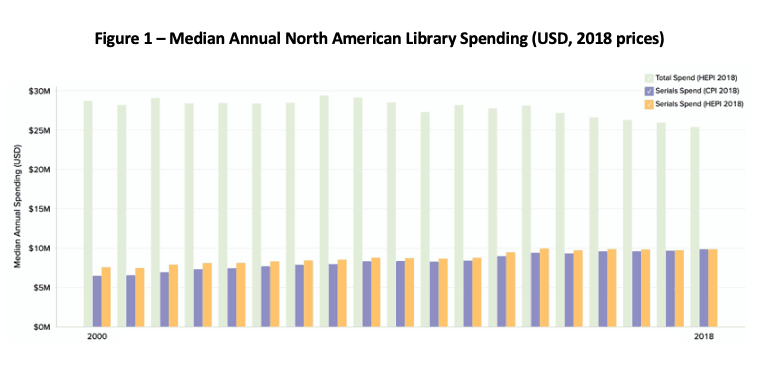Academic library budgets are the primary source of revenue for scholarly journal publishing. Given the global economic uncertainty surrounding Covid-19, this month we examine the outlook for academic library spending.
A Core Source of Revenue
Academic libraries are the majority contributor to scholarly publishing revenue streams. Although exact estimates vary, around 90% of scholarly journal market revenues come from subscription (or subscription-related) revenues, and 75% of that from academic libraries.
Libraries have been concerned that rises in the cost of purchasing journal subscriptions has significantly outpaced inflation. This is often referred to as the “serials crisis” by librarians and publishers alike. It has been noted for at least the last 25 years. Although some may suggest that it is specific to the 1990s, others suggest that it is an ongoing phenomenon.
Spending by Libraries
Industry figures are typically reported or gathered annually and stated at current market values. Of course, when analyzing them over time, we need to adjust for inflation. We do this using both the sector-specific Higher Education Price Index (HEPI1) and the general Consumer Price Index (CPI). Figure 1 shows the results.

Sources: ARL, Commonfund Institute, Delta Think analysis. © 2020 Delta Think, Inc.
We can see that median spending on journals (“serials”) continues to increase in real terms (regardless of the inflation index used), while overall library spend are now declining. This suggests that budgets, too, are in real terms decline. Note: The sample2 includes 100 universities in the US and 16 universities in Canada, covering many significant academic libraries.
Library Spending vs. Publishing Activity
Actual prices paid by libraries are not available. Deals are usually confidential, and pricing includes a mix of print, digital, bundles, and discounting. However, by comparing library spending on serials with other measures, we can get a read on the challenges at work. Figure 2 shows a mix of measures, indexed to the year 2000 so you can see relative movement over time.

Sources: ARL, Commonfund Institute, SCImago (Scopus), OECD (2020), Delta Think analysis. © 2020 Delta Think, Inc.
Although spending on serials is growing faster than inflation, the data suggest that this headline masks a complex story.
- Serials spending as stated (the pink line) is the fastest growing of the indicators and appears to be outpacing growth in scholarly output and GERD3.
- However, when adjusted for inflation (the bottom two blue lines), serials spending is the slowest growing of our measures.
- The inflation measures average around 2% – 3% per year, compared to headline price increases exceeding 5% experienced by many libraries.
- The numbers of articles in the indexed literature (in orange) roughly tracks inflation-adjusted GERD (in yellow), as we explored last month. Both are growing at 2-3 times the rate of spending on serials.
- The unit of purchase for subscriptions is typically the journal (whether bundled or not); the number of indexed journals (not shown) is growing at a similar rate to CPI-adjusted serials spend.
- Since 2013, real-terms growth in serials spending has slowed – the HEPI-adjusted amount is flat-lining – while publishing output has continued largely unchecked.
As ever, subscribers to our database can drill into the details and explore further measures.
Conclusion
Analyzing data on library spend can be problematic. At the core of the debate is how value is defined. As well as issues of pricing itself (discounting vs. retail; print vs. digital; current prices vs. inflation-adjustments), many measures can be examined by studies looking at the costs paid by libraries. These include cost per article read, cost per download, cost per citation, costs relative to Impact Factor, or costs relative to selectivity (or “prestige”) of journals.
Whatever the definition, it is clear that in real terms, serials spending is growing, and is taking an increasing share of library budgets (from around 25% share in 1998 to just under 40% share in 2019 in our data). In this sense, there is a “serials crisis.” Trends such as falling costs per download and rising usage add further tension. The argument that libraries are getting “more stuff” is used by many to justify increased prices (and increased costs).
If publishing output has grown faster than serials spending, then the difference suggests publishers have not raised prices commensurate with growth in output. The data suggest that the fundamental problems lie with flat library budgets, which are failing to keep up with increases in spending on R&D in the Higher Education sector. Over the last twenty years, university budgets have almost doubled in real terms, while the proportion spent on libraries has almost halved.
Arguments that an increase of research volume should translate to library price rises are not new. Neither is the question of how sustainable such price increases are, as output continues to outstrip library budgets. Given the current state of the world economy, could this lack of scalability be exacerbated by more rapidly tightening library budgets? Will we see the current configuration of business models finally run out of runway? Is the longstanding way in which research is disseminated becoming strained to the point of obsolescence?
We are sure that the debate about value will continue. However it takes shape, the bottom line is that if libraries don’t have the budget, they can’t spend the money – no matter how good the deal on offer.
1 The Consumer Price Index (CPI) accounts for inflation based on a typical “basket of goods” and will be familiar to many. However, academic spending needs are different to those of the consumer. So we also use the Higher Education Price Index (HEPI), which we think better represents the inflationary pressures on US Academia. The HEPI is increasing on average 20% faster than CPI, suggesting that costs for Higher Education institutions in general are rising faster than those for consumers. We do need both indexes, however, as Macroeconomic Indicators typically use CPI to adjust for inflation.
2 ARL Statistics 2017-18, Association of Research Libraries, Washington, D.C.
3 GERD: “Gross domestic spending on R&D is defined as the total expenditure (current and capital) on R&D carried out by all resident companies, research institutes, university and government laboratories, etc., in a country. It includes R&D funded from abroad but excludes domestic funds for R&D performed outside the domestic economy. This indicator is measured in USD constant prices and Purchasing Power Parities (PPPs)” It is inflation-adjusted based on the CPI.

TOP HEADLINES
Scholarly publishers are working together to maximize efficiency during COVID-19 pandemic – April 27, 2020
“Scholarly publishers are working together to maximize the efficiency of peer review, ensuring that key work related to COVID-19 is reviewed and published as quickly and openly as possible. The group of publishers and scholarly communications organizations…is working on initiatives and standards to speed up the review process while ensuring rigor and reproducibility remain paramount.”
Clarivate Introduces New Open Access Data into Web of Science Journal Citation Reports – April 23, 2020
“Clarivate Analytics today announced the addition of open access data to Journal Citation Reports profile pages to increase transparency around open access models in scholarly publishing. Journal Citation Reports is an annual journal report from the Web of Science, the world’s largest publisher-independent global citation database.”
OSI’s Plan A launched – April 20, 2020
“The Open Scholarship Initiative officially launched Plan A today. Plan A is OSI’s 2020-25 action plan, synthesizing the significant themes and recommendations that have emerged from OSI during it’s last five years of work.”
New publishing model pins hopes on ‘unity of purpose’ – April 16, 2020
“Higher education leaders in South Africa are looking to move to a European model for open access (OA) publishing of scholarly articles as soon as possible, according to the body that coordinates the country’s public universities. Under the plan, an estimated ZAR500 to ZAR600 million, which is currently being spent on journal subscriptions, would be funneled into new ‘transformative’ agreements with the big five academic publishers.”
“Springer Nature welcomes the decision from cOAlition S to support Transformative Journals. Subject to acceptability of the yet to be published transparency requirements, it commits to transition the vast majority of its Springer Nature-owned English language journals that are not already Open Access, including Nature and the Nature Research journals, to become Transformative Journals.”
cOAlition S publishes updated criteria for Transformative Journals – April 8, 2020
“cOAlition S endorses several strategies to encourage subscription publishers to transition to full and immediate Open Access (OA), with a business model where fees are levied for providing publishing services rather than subscription fees for reading. Under this model all published research articles can be freely accessed, read and built upon.”
Open Research Community launches, connecting experts worldwide – April 7, 2020
“The Open Research Community (ORC), an interactive platform which launched today after a test phase, offers users worldwide the opportunity to expand their professional networks on the topics of Open Access (OA), Open Research and Open Science.”
A better understanding of APC funding sources could accelerate the transition to open access – April 6, 2020
“A new report published by Springer Nature indicates that a better understanding of the sources of funding for article processing charges (APCs) could accelerate the transition to open access (OA) publishing…The whitepaper draws on data from a survey of over 1000 Springer Nature authors, as well as 16 interviews with representatives from institutions.”
OA JOURNAL LAUNCHES
April 23, 2020 | SPIE To Launch New Journal of Optical Microsystems in January | “SPIE, the international society for optics and photonics, has announced the launch of a new Gold Open Access journal, the Journal of Optical Microsystems (JOM), which will publish cutting-edge research of optical and photonic microsystems.” |
April 9, 2020 | OUP and American Physiological Society announce new Open Access journal | “Oxford University Press (OUP) and the American Physiological Society (APS) are delighted to announce that the new journal,Function, is now accepting submissions. Function will provide an open access multidisciplinary home for cutting edge research describing major advances in basic, translational and clinical science that significantly broaden the physiological understanding of biological function.” |

